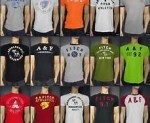by Mahek Khetani| Staff Writer
Preparing for the day, fashion student Anela Brunson pairs items together from stores like Forever 21 and Urban Outfitters to create her own trend rather than following them. Times have changed from where a single logo was the novelty among our peers.
In 2012, American Eagle announced that their third quarter profits were down by 68% while it’s rival, Abercrombie and Fitch, lost 30% of its value in the past year, along with shareholders and customers demanding that Mike Jeffries step down as CEO. Aeropostale, taking the least hit, is only 15% down in third quarter sales. So why are teens, who were once scrambling for the “in vogue” labels, suddenly giving it the cold shoulder?
“I believe they fail because they always fit to a certain mold and they stick to a preppy kind of thing and don’t take risks, they always put their name on all their clothes, and only middle schoolers are into that, and kids will grow out of that stage so they should look for what older people will also wear. Like Urban Outfitters, they take risks and there’s actually fashion in it other than just the logo with crazy prices,” said senior Anela Brunson.

The most common reason for loss of popularity among these stores have to do with the fading trend of the logo. A couple of years ago, that logo indicated a certain status of popularity in schools but now, all it says about a person is that they paid too much for a plain, cotton shirt.
“A lot of new stores coming to light and focusing on different age groups and targeting multiple styles at once as opposed to Hollister which is all kinda the same. The appreciation of individual style contributes a lot, there’s people now that experiment with color, style, shoes and all these ways of accessorising that stores like, lets say, Abercrombie, don’t have to offer,” said senior Anna Aitken.
It’s definitely a new era in fashion, because now it’s not about what someone is wearing, but rather how they’re wearing it. Anybody can walk into Nordstrom and get this season’s Cavalli, but fashionistas are commended for their ability to create a unique and envious outfit using, well, anything.
“That whole hipster trend nowadays, everyone wants to be different and stand out among the crowd and that started when people wanted to express themselves and their personality. Stores like Hollister need to look at the new generation, with everyone comes a new style, a new fad and as one comes to an end, another is born, right now people are dressing in a nice, stylish casual and those options aren’t available at Hollister and Abercrombie but places like Ralph Lauren, Banana Republic, which are more stylish by my opinion,” said junior Morgan Cooper.
Whether it’s a matter of suddenly embracing individuality or not, in the end, retailers like American Eagle and Aeropastale just aren’t cool anymore according to the teenage demo.
“Trends just change over time. People like certain things then after a while its not popular anymore, the cool kids aren’t wearing it anymore, so everyone stops. Teenagers like one thing one minute and the next minute they don’t and I think it has a lot to do with Pinterest, Instagram, and Tumblr. They see stars who aren’t wearing ‘trendy’ stuff anymore but kinda making stuff their own so I think they’re kinda going out thinking, hey maybe i should do that too but it’s in a way that they’re creating their own style while still copying the norm but not in a mainstream way,” fashion design teacher Valerie Diep said.
The eruption of social media in today’s generation is the biggest factor behind what’s hot and what’s not. Along with differentiating which stores teens should be shopping at, sites such as Instagram and Tumblr provide “do it yourself” looks as well as offering give aways and other promotions.
“Apps have sales for clothes and twitter lets you know if stores are having a big blowout, that’s why I think the only way stores like Abercrombie can get back on top is lowering their prices. People go online and post a how to create this outfit without spending the money by using similar and cheaper items that some people might already have in their closet which is great and way easier,” said senior Mason Myers.
Then again, social media also contributes to the destruction of a store’s reputation. Such as the boycotts against Abercrombie and Fitch after a statement that CEO Mike Jeffries had released saying that he wanted the store’s apparel to only cater to people of a smaller size. While that is one of the most arrogant and senseless comment a CEO has ever made to the public, popular retailers are known for size inflation.
“They already vanity size places like that, you’re a size 6 somewhere else and at Abercrombie or something you’re a size 2. Somebody is a larger size at one store but at another they’re smaller because retailers want people to think they’re skinnier than they actually are, so they might carry larger sizes but they’re not marked at that size,” said Diep.
However, no matter the amount of loss, dignity is the key to redemption. the public shouldn’t expect a big 90% blowout from American Eagle because lowering prices means a loss in value of the trademark itself.
“I don’t think it’s about being too expensive for people, quality and price go hand in hand a lot of the time, like J.Crew might have the same thing as Old Navy but people pay for labels, just like how people pay for the Starbucks coffee rather than homemade coffee,” said Cooper.

